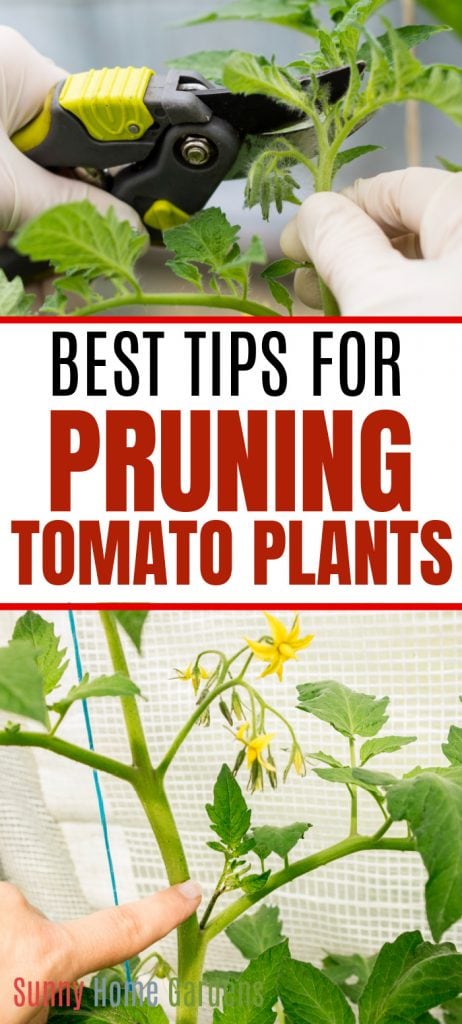When growing any plant we always want it to yield bigger and better fruits and flowers. Other than giving plants love and care, you can also help them maintain better health and produce more by pruning regularly.
Although tomatoes are one of the plants that don’t require pruning to thrive, it can help with disease prevention,pest control, and yield.
Table of Contents
Do You Need To Prune Your Tomatoes?

Some people believe that pruning your tomato plant can improve the production of fruits and the overall health of the plant, there are others who claim that it damages the plant unnecessarily.
Many studies show that pruning your tomato plants can make a marked difference. It can improve the yield, size, and taste of your tomatoes.
Why Pruning Can Help Your Plants
The main reason people choose to prune their tomato plants is that it helps the plants direct their energy towards producing fruits rather than more foliage.
Pruning tomatoes also helps with disease and pest control by allowing more air flow through the leaves. Damp leaves can lead to many diseases. Pruning your plants will also help you determine what pests you might have and what sort of damage they’re causing.
When a plant is pruned properly, it receives adequate sunlight, boosting the growth of the plants and faster fruit production. Since each leaf has plenty of room and is supported off the ground, it maximizes the efficiency of photosynthesis.
When To Start Pruning

When deciding the best time to begin pruning your plants you’ll want to watch your plants for signs that the time has come.
Check the plants for any signs of yellowing. Once the leaves and stems below the first set of flowers start turning to yellow that signals the time to begin pruning.
You can also begin to keep an eye out for what gardeners usually like to call suckers which are the tiny new branches that sprout in the spot where the branch meets the stem. These suckers will drain the energy from the rest of the plant, causing it to bear fewer and small fruits.
Suckers are easy to spot, they grow right in between the main stem and the branches. To help illustrate this, make a fist like you’re going to show your muscles, now look right in the bend of your arm, that’s where the sucker would grow on a tomato plant. It will be right in that “V” on the plant. Always keep your eye on the main stem when beginning to prune your tomatoes and never cut the main stem.
How To Prune Tomato Plants?
To prune, simply remove the suckers. Suckers can be easily removed by pinching them with your fingers. Grab the growing tip by the base between your forefinger and thumb then bend it back and forth until the sucker snaps cleanly. They are very easy to remove.
However, for those that got away from you and are now longer in size, you can use a pair of pruning shears. Remember to disinfect and clean them as you use them from one plant to another to prevent the spread of any possible diseases.

It’s better to remove these suckers while they’re still small. Removing a large number of suckers at one time can stress your tomato plant, thus, prolonging them to yield fruits. Once you have done your first pruning, just keep an eye out about every week for any new suckers and remove them.
Remove the yellow leaves from the plants as well. These leaves use up more sugar than they actually produce. This will keep your tomato shrub fresh and will also prevent diseases from affecting the plant.
Also make sure to prune off any broken, damaged, or diseased parts as soon as possible to help your plants stay healthy. Not pruning these leaves will provide an entry point for fungi and diseases to enter and wreak havoc with your plant and can even spread to other plants if these problems are left unchecked.
More Tips When Pruning Your Tomato Plants
If you see the branches are low hanging or touching the ground, it is time to prune or remove them. Leaves that are touching the ground can spread fungi, bacteria, and infections through the rest of the plant. Use a pair of pruning shears to remove the branch.
The best time to prune your plants is during early morning on a dry day. This will allow the wounds from pruning to heal cleanly and will also reduce the chances of diseases and viruses from infecting the plant.
After pruning your tomato plants you might also consider spraying them with a peppermint oil mixture as wounded plants send out pheromones that attract pests. The peppermint oil scent should deter pests. You can also add some cotton balls soaked in the oil around the garden to repel any predators, too.

It’s best to set supports like trellises, stakes, or cages around your tomato plants before you begin to prune.
Pruning your tomatoes is a matter of choice. However, it won’t hurt the plants if you remove the suckers which can affect the plants negatively. It will not only help them produce bigger fruits, as well as help prevent plants from acquiring diseases and fungi.





God Bless You and your gardens as well as mine!